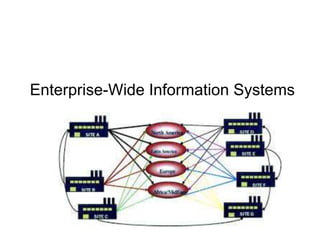
Enterprise Systems.ppt
- 2. Enterprise Systems • Enterprise systems – Information System supports various business activities for internal operations (manufacturing, order processing, human resource management) as well as external interactions with customers, suppliers, and business partners. – However, the problem is they were built on different platforms (mainframe/minicomputer). – Enterprise systems are information systems that allow companies to integrate information across operations on a company-wide basis – Also known as enterprise-wide information systems
- 3. Enterprise Systems • Enterprise systems – Rather than storing information in separate places throughout the organization, enterprise systems provide a central repository common to all corporate users. – It provides a common interface and allows personnel to share information seamlessly no matter where the data is located.
- 4. Enterprise Systems • Enterprise systems – The emergence of Internet and the Web has resulted in the globalization of customer and supplier networks and opened up a new opportunities and methods to conduct business. – New business needs/expectations: • Higher levels of customer services, faster and efficient product development to compete in global market. • Internally focused systems support functional areas, processes within the organization. These activities can be viewed as a series of links in a chain along which information flows within the organization. At each stage in the process, value is added in the form of the work performed by people associated that process.
- 5. Enterprise Systems Information flow for an order Information begins to accumulate at the point of entry when a customer sends an order to the company and flows through the various links.
- 6. Enterprise Systems Information flow for an order • When a customer places an order, the order is entered into an order-entry application. • The information containing the order is sent to the fulfillment department. • Fulfillment department picks the items from inventory, packages them for distribution, and produces packing list. • The package, along with the packing list, is forwarded to the shipping department. • Shipping department coordinates the shipment, produces invoice, and sends the package and invoice to the customer.
- 7. Enterprise Systems • Externally focused systems coordinate business activities with customers, suppliers, and business partners who operate outside the organizational boundary. • Systems that communicate across organizational boundaries are called interorganizational systems (IOS).
- 8. Enterprise Systems – Interorganizational systems (IOS) • The key purpose of an IOS is to streamline the flow of information from one company’s operations to another’s. • It provides electronic transmission of information to another company. • Competitive advantage can be accomplished here by integrating multiple business processes to meet a wide range of unique customer needs. • Sharing information between organizations helps companies to adapt more quickly to changing market conditions.
- 9. Information flow across organizational boundaries
- 10. Information flow across organizational boundaries • When a company places an order for components, the supplier performs the shipping activity. The supplier delivers a physical package and electronic invoice to the customer. • The customer’s receiving department takes the delivery and verifies the invoice. Then the receiving department stocks the items in the inventory and updates the inventory level.
- 12. Enterprise Systems • Internally Focused Applications – Value chain – the set of business activities – Functional areas can be broken down into primary and support activities. – Primary activities are functional areas within an organization that process inputs and produce outputs. – Support activities are those activities that enable primary activities to take place.
- 13. Enterprise Systems • Internally Focused Applications – Primary activities include: • Inbound logistics • Operations and manufacturing • Outbound logistics • Marketing and sales • Customer service
- 14. Enterprise Systems • Internally Focused Applications – Support activities include: • Infrastructure (hardware & software) • Human resources (hiring, interview scheduling, payroll, benefits) • Technology development (software selection, Internet, intranet, extranet) • Procurement (purchasing of goods and services required as inputs primary services)
- 15. Enterprise Systems • Externally Focused Applications – Integrate internal applications with those outside: suppliers, partners, customers – Upstream information • Information received from another organization – Downstream information • Information sent to another organization
- 17. Types of Enterprise Systems • Packaged applications • Custom applications • Stand-alone applications
- 19. Types of Enterprise Systems • Legacy Systems – Older systems – Tend to be infrastructure-specific – Usually linked to a specific business need – Not integrated
- 20. Types of Enterprise Systems • Enterprise Resource Planning – Integrated applications – ERP systems • Baan • Oracle • PeopleSoft • SAP • J.D. Edwards
- 21. Types of Enterprise Systems • ERP Implementation – Modules – “Vanilla” version – Customizations – Best practices – Business process reengineering (BPR)
- 22. Types of Enterprise Systems • Customer Relationship Management (CRM) – Sales Force Automation (SFA) – New opportunities for competitive advantage – Examples: • MGM • American Airlines • Marriott International
- 23. Types of Enterprise Systems • Supply Chain Management (SCM) – Supply chain – the producers of supplies that a company uses – Supply network – What if supply chain does not collaborate? – Two objectives of upstream information flow: • Accelerate product development • Reduce costs associated with suppliers
- 24. The Formula for Enterprise System Success • Secure executive sponsorship • Get help from outside experts • Thoroughly train users • Take a multidisciplinary approach to implementation